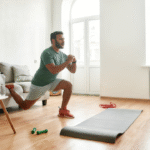
Daily Exercises to Improve Physical Health: A Complete Guide for Everyone
September 4, 2025
How to Start an Online Business from Home: A Complete Beginner’s Guide
September 4, 2025Staying active is one of the simplest yet most powerful ways to improve your overall physical health. In today’s world, where sitting for long hours has become part of our lifestyle, finding ways to move more is essential. Being active doesn’t just mean hitting the gym every day; it also includes small daily choices that keep your body in motion, strengthen your muscles, and improve your heart health.
In this article, we’ll explore practical strategies to stay active, explain why physical activity is so important, and provide a realistic guide for people of all ages.
Why Staying Active is Important for Physical Health
Movement is the foundation of a healthy body. When you stay active, you are not only keeping your weight under control but also:
- Improving heart health: Regular physical activity strengthens your heart and improves blood circulation.
- Boosting energy levels: Exercise increases oxygen flow in your body, making you feel more energetic throughout the day.
- Strengthening muscles and bones: Staying active helps prevent muscle loss and keeps your bones strong.
- Reducing health risks: Physical activity lowers the risk of chronic diseases such as diabetes, high blood pressure, and obesity.
- Enhancing mood: Exercise releases endorphins, also known as “happy hormones,” which reduce stress and anxiety.
In short, an active lifestyle is one of the best medicines you can give yourself.
Simple Ways to Stay Active Every Day
You don’t always need a gym membership or expensive equipment to be active. Small lifestyle changes can add up to great results. Here are some easy ways to include activity in your daily routine:
1. Walking More
Walking is one of the simplest and most effective exercises. Try to walk whenever possible:
- Take the stairs instead of the elevator.
- Park your car farther from your destination.
- Go for a 15–20 minute walk after meals.
2. Desk Exercises at Work
If you spend long hours sitting, add small stretches and movements:
- Do shoulder rolls, neck stretches, or seated leg lifts.
- Stand up every 30 minutes and walk around for 2–3 minutes.
3. Home Workouts
You don’t need fancy equipment to work out at home. Bodyweight exercises like push-ups, squats, lunges, and planks can be done in just 10–15 minutes.
4. Fun Activities
Staying active doesn’t have to feel like exercise. Dance, gardening, playing a sport, or even cleaning your house can keep your body moving.
5. Family Activities
Include your family in your active lifestyle. Take evening walks, play outdoor games, or go cycling together. This keeps you healthy while also strengthening family bonds.
How Much Activity Do You Really Need?
Health experts suggest at least 150 minutes of moderate-intensity exercise per week (like brisk walking or cycling) or 75 minutes of vigorous exercise (like running or aerobic workouts).
That may sound like a lot, but if you break it down, it’s just 30 minutes of activity, five days a week. Even short 10-minute sessions throughout the day add up to the same benefits.
Staying Motivated to Be Active
The hardest part of staying active is not starting—it’s maintaining consistency. Here are some tips to keep yourself motivated:
- Set small goals: Start with 10 minutes a day and gradually increase.
- Track progress: Use a journal or a fitness app to see improvements.
- Find a workout buddy: Exercising with a friend makes it fun and keeps you accountable.
- Mix it up: Try different activities like yoga, swimming, or hiking to avoid boredom.
- Reward yourself: Celebrate small wins to stay motivated.
The Role of Nutrition in Staying Active
Being active and eating well go hand in hand. If your body doesn’t get the right fuel, you won’t have enough energy to stay active. Some nutrition tips include:
- Eat a balanced diet with fruits, vegetables, lean protein, and whole grains.
- Stay hydrated by drinking plenty of water.
- Avoid processed foods and sugary drinks that drain your energy.
Table: Active Lifestyle vs. Sedentary Lifestyle
| Aspect | Active Lifestyle | Sedentary Lifestyle |
|---|---|---|
| Energy Levels | High and consistent | Often tired and sluggish |
| Heart Health | Stronger heart and better circulation | Higher risk of heart disease |
| Weight Management | Easier to maintain healthy weight | Greater risk of obesity |
| Mood and Stress | Reduced stress, better mood | Increased anxiety and low mood |
| Longevity | Longer, healthier life expectancy | Higher risk of early health issues |
Long-Term Benefits of Staying Active
Making movement a priority in your daily life can bring long-term health benefits, such as:
- Maintaining independence as you age.
- Reducing joint pain and stiffness.
- Lowering the chances of chronic illnesses.
- Enhancing memory and brain health.
The earlier you start, the better—but it’s never too late to adopt an active lifestyle.
Conclusion
Staying active for better physical health doesn’t mean following strict workout routines or spending hours at the gym. It’s about making small, consistent choices every day—like walking more, stretching regularly, and including fun physical activities in your life. By doing so, you’ll strengthen your body, improve your mood, and increase your chances of living a longer, healthier life.
Remember, the goal is progress, not perfection. Even small steps towards an active lifestyle will lead to big improvements over time.
FAQs About Staying Active for Better Physical Health
1. How can I stay active if I have a busy schedule?
You can stay active by adding short movements into your day—take the stairs, walk during breaks, or do a quick 10-minute workout at home.
2. Can older adults stay active without heavy exercise?
Yes. Older adults can focus on light activities like walking, stretching, yoga, or water aerobics to keep their bodies strong and flexible.
3. Is walking enough to improve physical health?
Walking regularly, especially brisk walking, is excellent for heart health, weight management, and overall fitness. It may be enough if done consistently.
4. What should I do if I don’t enjoy traditional exercise?
Find fun alternatives like dancing, gardening, swimming, or playing sports. Physical activity should be enjoyable to stay consistent.
5. How long does it take to see the benefits of being active?
You may feel more energetic within a few days, but visible results like better strength, stamina, and mood improvements can usually be noticed within 4–6 weeks of regular activity.



